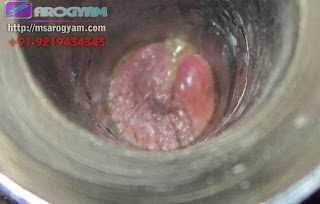Piles (haemorrhoids) - Treatment
Diagnosis
| Grade | Diagram | Picture |
|---|---|---|
| 1 |  |  |
| 2 |  |  |
| 3 |  |  |
| 4 |  |  |
Hemorrhoids are typically diagnosed by physical examination.[11] A visual examination of the anus and surrounding area may diagnose external or prolapsed hemorrhoids.[2] A rectal exam may be performed to detect possible rectaltumors, polyps, an enlarged prostate, or abscesses.[2] This examination may not be possible without appropriatesedation due to pain, although most internal hemorrhoids are not associated with pain.[3] Visual confirmation of internal hemorrhoids may require anoscopy, a hollow tube device with a light attached at one end.[5] There are two types of hemorrhoids: external and internal. These are differentiated by their position with respect to the dentate line. Some persons may concurrently have symptomatic versions of both. If pain is present the condition is more likely to be ananal fissure or an external hemorrhoid rather than an internal hemorrhoid.[5]
The veins around your anus tend to stretch under pressure and may bulge or swell. Swollen veins — hemorrhoids — can develop from an increase in pressure in the lower rectum. Factors that might cause increased pressure include:
- Straining during bowel movements
- Sitting for long periods of time on the toilet
- Chronic diarrhea or constipation
- Obesity
- Pregnancy
- Anal intercourse
It's also possible to inherit a tendency to develop hemorrhoids. Hemorrhoids are more likely as you get older because the tissues that support the veins in your rectum and anus can weaken and stretch with aging.
The exact cause of symptomatic hemorrhoids is unknown.[9] A number of factors are believed to play a role including: irregular bowel habits (constipation or diarrhea), a lack of exercise, nutritional factors (low-fiber diets), increased intra-abdominal pressure (prolonged straining, ascitis, an intra-abdominal mass, or pregnancy), genetics, an absence of valves within the hemorrhoidal veins, and aging.[3][5] Other factors that are believed to increase the risk include obesity, prolonged sitting,[2] a chronic cough and pelvic floor dysfunction.[4] Evidence for these associations, however, is poor.[4]
During pregnancy, pressure from the fetus on the abdomen and hormonal changes cause the hemorrhoidal vessels to enlarge. Delivery also leads to increased intra-abdominal pressures.[10] Pregnant women rarely need surgical treatment, as symptoms usually resolve after delivery.
.jpg)
.jpg)
.jpg)
.jpg)
.jpg)
.jpg)
.jpg)
.jpg)









.jpg)
.jpg)
.jpg)
.jpg)
.jpg)
.jpg)
.jpg)
.jpg)
.jpg)
.jpg)
.jpg)
.jpg)
.jpg)
.jpg)
.jpg)
.jpg)
.jpg)
.jpg)
.jpg)
.jpg)
.jpg)
.jpg)
.jpg)
.jpg)
.jpg)
.jpg)
